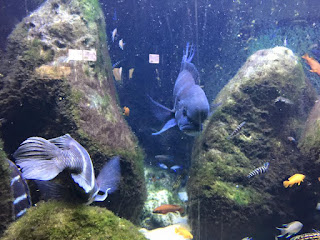About this sound Wilhelma (help·info), built as a royal palace, is now a 30-hectare (74-acre) zoo and botanical garden in the northern suburbs of Stuttgart, Baden-Württemberg, Germany. It is Europe's only large combined zoological and botanical garden, and is home to over 8,000 animals representing more than 1,000 different species, as well as more than 5,000 species of plants.
The upper section of the zoo includes an impressive stand of sequoia trees.
The zoo immediately adjoins a public park to its west, laid out in the 'English landscape style' of rolling grass and informal groups of trees. In landscape terms this perfectly complements the landscape of the zoo.
History
The Wilhelma was originally a royal palace, in Moorish Revival style, and echoes such buildings as the Alhambra Palace. Besides animals and plants, the Wilhelma is therefore also worth visiting for its intact mid-19th century architecture.
After being closed to the public during World War II, Wilhelma was opened again in 1949 with an azalea show, followed by the "Great Aquarium Show." In 1951, giraffes, zebras, antelopes, and penguins arrived as part of a special exhibition, but they were kept after the exhibition ended, which marks the beginning of the zoo. Elephants and tigers were added in 1952.
Exhibits
The zoo is famous for keeping great apes (bonobos, orangutans, and gorillas), all in families with offspring, as well as for its aquarium featuring animals and plants from all over the world. The botanical gardens contain Europe's biggest magnolia grove. It was also the home of the polar bear Wilbär.
As is common in many German zoos, barriers between spectators and animals are minimal. The bird enclosures let visitor enter and wander among the birds in a landscaped environment.
There is an extensive insectarium on the grounds. There are many types of insects grown and kept live for the public to see, including African colored scarab beetles, among many others. There are butterflies, spiders, millipedes, and several beetle species that are continually cultivated and kept living, by breeding generation after generation of the individual species of choice.
Breeding and conservation
A particularly unusual feature is the "hatchery" where chicks can be watched hatching and mother birds feed their chicks at very close quarters.
The zoo has become a center for raising motherless apes from all over Europe.
Breeding of invasive plant
The aquarium staff was responsible for inadvertently breeding a strain of Caulerpa taxifolia, such that it became a highly invasive plant known as "Killer Algae" which "has had severe negative consequences for biodiversity"
Wilhelma Stuttgart Zoologisch-botanischer Garten Wilhelma
Wilhelma 13
70376 Stuttgart
Telefon: +49 (0)711 540 20 (Mo-Do: 8.15 Uhr - 16.00 Uhr, Fr. 8.15 Uhr - 15.30 Uhr)
Fax: +49 (0)711 540 22 22
info@wilhelma.de
www.wilhelma.de
The Stuttgarter Wilhelma Zoo: from ape to zebra
The Wilhelma is the only zoological and botanical garden in Germany and thanks to the unique combination of zoo, botanical garden and historic park unique in the world.
Here visitors can experience some 8,000 animals of almost 1,000 species and 6,000 plant species - and the heart of a former royal garden with the flair of 1001 nights. Thus, each visit not only for exciting expedition into the animal and plant kingdoms, but also for small journey into the history of the country.
History of Wilhelma Stuttgart
Beginning in 1842, King Wilhelm I of Württemberg built the Wilhelma as "garden house with residential buildings and ornamental greenhouses in Moorish forms". After the 2nd World War, in which a large part of the historic complex was destroyed, the Wilhelma transformed gradually from the botanical in a zoological and botanical garden.
A visit to the Wilhelma is worth in every season: Whether in March when the largest magnolia grove north of the Alps to flowering, in spring and summer when many animals have offspring and in autumn and winter when the warm greenhouse and animal homes can enjoy peace.
Wilhelma is not a zoo in the traditional sense, but the Zoo and Botanical Gardens in Stuttgart district of Bad Cannstatt is actually a work of art from plants, animals and architecture. With approximately 1,000 animal species, Wilhelma is one of the most diverse zoo is not only in Germany but also worldwide. For this purpose, some 5,000 plant species and plant varieties coming in the botanical garden Wilhelma Stuttgart. Today's Park Wilhelma belongs to the historical heritage of the country Baden-Wuerttemberg. The park has undergone a transition from a purely private retreat of a king to the zoological and botanical gardens in Stuttgart with nearly 2.1 million visitors annually.


























































